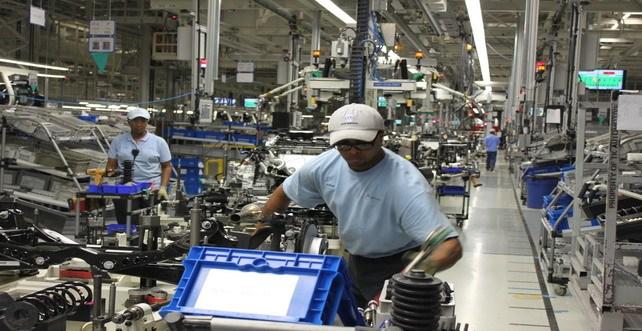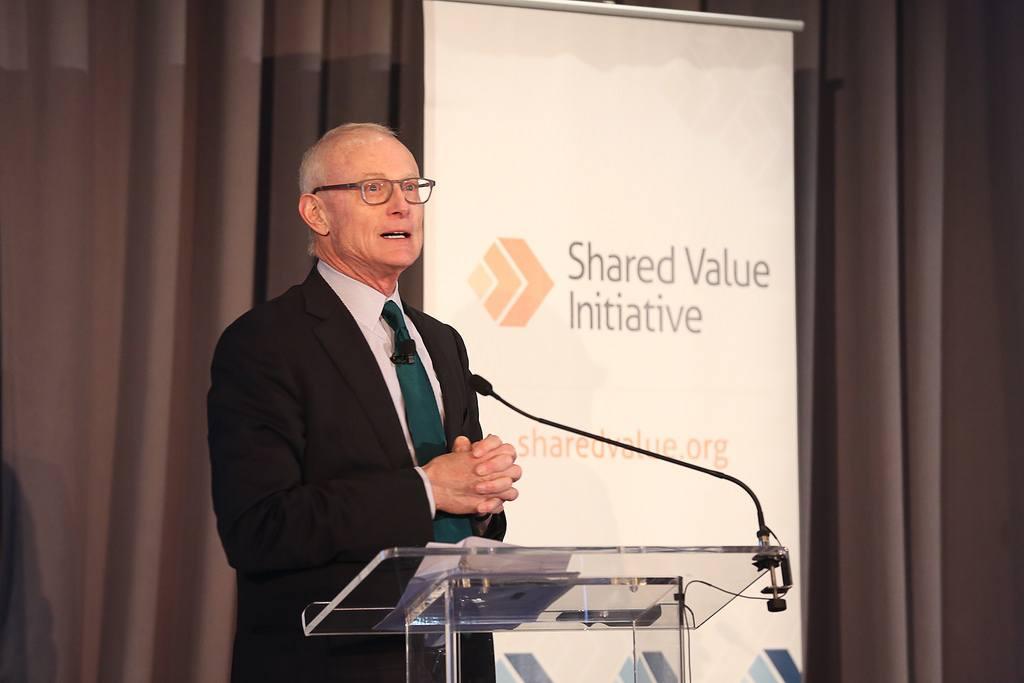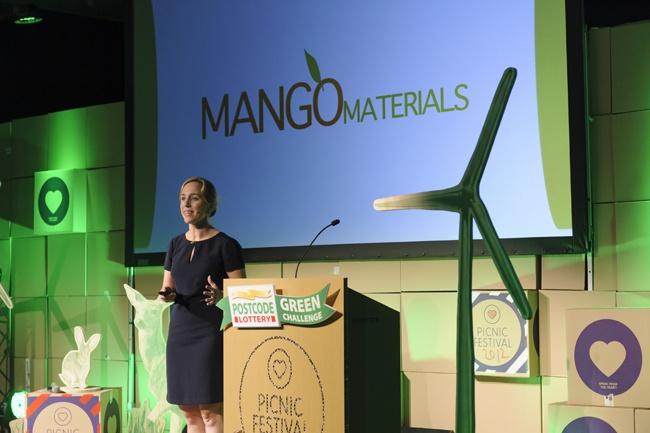Hanwha Embraces a Solar Profile with Office Tower Retrofit in Seoul


One of the advantages of belonging to the clean tech field is that your facilities can double as a showcase for your products. So when it came to renovating its outdated headquarters in Seoul, the diversified global corporation Hanwha took the ball and ran with it. Among other energy-saving elements, the 1980s-era office tower will sport a new facade that features solar panels.
For those of you familiar with Hanwha's roots in the commercial explosives, chemicals, defense-related manufacturing, retail, leisure and insurance sectors, the solar panel angle might seem to be a bit of a mismatch. However, the company's most recent ventures have included a foray into the solar market in the form of Hanwha Solar,and the newly redesigned headquarters will cement that identity throughout the entire corporation.
The new Hanwha solar image
The new design comes courtesy of the global firm UNStudio. It represents a "responsive," energy-aware approach in which elements of the facade interact with the building's interior and other systems. As described by UNStudio's Ben van Berkel:
"...The facade design for the Hanwha HQ implements fully inclusive systems which significantly impact the interior climate of the building, improve user comfort and ensure high levels of sustainability and affordability. Through fully integrated design strategies today’s facades can provide responsive and performative envelopes that both contextually and conceptually react to their local surroundings, whilst simultaneously determining interior conditions."
The solar panels are actually just one part of the Hanwha facade project. In the new facade, clear insulated glass and aluminum framing will replace the existing horizontal bands of dark glass, and the solar panels will be located on some of the existing bands of opaque paneling.
Specifically, the south side of the building is angled to a south-southeast orientation. Opaque panels on that facade will be retrofitted for solar cells, taking advantage of the most efficient location for energy harvesting.
The solar cell angle has been grabbing some headlines for Hanwha, so mission accomplished in that regard, but there are additional solar-related, energy efficient design elements.
While the south side of the building is more opaque to reduce solar heat gain (and enable placement of the solar panels), the north side has an open design that maximizes the use of daylighting. Also helping to reduce heat gain on the building is the use of shading.
In addition to the facade redesign, UNStudio also redesigned the common spaces, meeting areas, auditorium and executive offices, and the exterior landscaping.
It's a solar world, we just occupy it
Hanwha's solar makeover also illustrates three overlapping sustainability trends.
One is the inherent green-ness of extending the usefulness of existing built spaces. Although there has been some debate over the worth of replacing outdated buildings with new, more energy efficient construction, the consensus has been forming on the side of retrofitting.
The other is the trend toward repurposing buildings as energy-generating dynamos. That includes add-ons like rooftop solar panels, as well as building integrated solar features such as the Hanwha facade. Solar roof tiles, exterior curtain walls and soon-to-be-realized transparent solar windows are among the other possibilities.
It's also worth noting that when you combine the first and second trends, you get new energy sourcing by double-dipping into the built environment, which is a vast improvement over destroying virgin habitat to harvest fossil fuels.
The third trend follows from the second, and that is the growth of the distributed energy sector. From a negligible force just a few years ago, the distributed energy market has grow so vigorously that traditional utility companies have been caught flat-footed.
Image (cropped): Courtesy of UNStudio.
ARPA Bridge Fund to Conserve 15 Percent of Brazil's Amazon Rainforest


Whether it's climate change, biodiversity loss, the degradation of water and land, or social, economic and political inequality, taking action to conserve tropical forests is hailed as one of the most effective ways to address multiple ills. Real progress in overcoming divisions and actually stopping tropical deforestation while enhancing the well-being and livelihoods of local residents has been hard to come by, however.
Encouragingly, new partnerships and collaboration between traditionally antagonistic groups–environmental NGOs, big business and, at times, national governments–are building new pathways for sustainable development.
On May 21, for example, the Brazilian government, the World Wildlife Fund (WWF) and partners announced the launch “of a $215 million fund to ensure the long-term protection of the world's largest network of protected areas–150 million acres (two Californias' worth) of Brazilian Amazon rain forest."
The Amazon Protected Areas Program
The Amazon Region Protected Areas Program (ARPA) aims to protect 15 percent of threatened tropical rain forest ecosystems in the Brazilian Amazon. The ability to raise the capital necessary to establish and maintain the network of protected areas was a key driver in concluding the landmark agreement, “and sets a precedent for large-scale biodiversity conservation,” according to WWF.
Nations with large, rapidly developing economies, such as Brazil, have often argued and reserved the right to pursue the same, or at least similar, paths of economic development taken by industrially developed world leaders such as the European Union (EU), the U.S. and Japan. Those opposed counter that more dynamic, equitable and sustainable alternative development pathways have opened up and should be pursued. By establishing ARPA, Brazil is charting such a course.
The Brazilian government; WWF; the nonprofit Brazilian Biodiversity Fund (FUNBIO); Larry Linden, founder of the Linden Trust for Conservation (LTC); and the Gordon and Betty Moore Foundation teamed up to create the long-term financing plan for ARPA that was crucial to establishing the protected areas network.
ARPA's innovative financing plan gathers funds from a variety of public and private-sector partners, including the German government, the Inter-American Development Bank (IADB), the United Nations Global Environment Facility and WWF. It also breaks new ground in terms of providing “the first-ever opportunity to properly manage and monitor a large-scale protected area system,” WWF explains in a news release.
ARPA spans some 128-million acres of "richly bio diverse rainforest – the size of one-and-a-half Californias,” WWF highlights. Some of the funds raised will be used to add another 22 million acres in coming years.
Highlighting the importance of ARPA's creation, WWF President and CEO Carter Roberts stated:
“The explosion in demand for natural resources has made our parks and world heritage sites vulnerable. So we convened leading financial thinkers and philanthropic partners to create a plan for a first-of-its-kind bridge fund to ensure ARPA’s inspiring success story can be told forever.”
A landmark agreement for biodiversity conservation
Looking to deliver on its commitment to conserve at least 10 percent of its Amazon rain forest, Brazil's government originally created the ARPA program in 2002. As WWF Brazil CEO Cecilia Wey de Brito explained:
“The Brazilian rainforest is at the heart of our country. It is what defines us. The Brazilian government’s leadership in helping to create and maintain this fund provides us with more confidence than ever that we can slow the arc of deforestation in our rainforest and create a model for large-scale conservation worldwide.”
The $215 million in ARPA funds will be disbursed gradually, starting at a high level that will be reduced over time. Disbursing funds in this manner will enable Brazil “to steadily increase its internal funding and assume full responsibility for funding in perpetuity by the time the bridge fund is depleted approximately 25 years from now,” WWF adds.
Images credit: 1) & 3) WWF; 2) FUNBIO
EDF, Smithfield Foods Collaborate to Reduce Fertilizer Runoff


The Environmental Defense Fund is collaborating with Smithfield Foods and its livestock production subsidiary, Murphy-Brown LLC, to help farmers optimize fertilizer application on livestock grain. More efficient application of fertilizer leads to a reduction in greenhouse gas emissions and water pollution, while lowering farm input costs and maintaining crop yields.
Crops need fertilizer, but too much nitrogen fertilizer can run off the farmland and into water sources, including lakes and streams. Excess amounts of fertilizer also emits nitrous oxide, a greenhouse gas 300 times more potent than carbon dioxide. The agriculture sector is the fifth largest source of GHG emissions in the U.S.
Nitrous oxide accounted for about 6 percent of all U.S. GHG emissions from human activities in 2012, but it accounts for about 40 percent globally. The Environmental Protection Agency (EPA) cites agricultural soil management as the largest source of nitrous oxide emissions in the U.S. In 2012, agricultural soil management accounted for about 75 percent of all nitrous oxide emissions in the U.S. Nitrous oxide emissions have increased in the U.S. by about 3 percent between 1990 and 2012--and are projected to increase by about 5 percent between 2005 and 2020, mostly from agriculture.
Farmers who sell grain to Murphy-Brown will be taught through the program to use new tools and practices to more precisely use fertilizer. The goal of Murphy-Brown, which raises hogs in North Carolina, is to have 75 percent of its grain-sourcing acres in the Southeast participate in the fertilizer optimization program by 2018. The program will start in North Carolina, Virginia and South Carolina, and will expand to Midwest farmers in 2015. EDF estimates that through the collaboration, Smithfield will reduce excess nitrogen fertilizer on more than 450,000 acres and reduce GHG emissions from agriculture by over 60,000 tons, equivalent to taking about 13,000 cars off the road.
The program is part of EDF’s Sustainable Sourcing Initiative, which works with farmer networks to both identify and reduce environmental impacts of agriculture in the supply chain. The Sustainable Sourcing Initiative has helped reduce fertilizer loss by an average of 20 percent on a half million acres.
EDF is working with Walmart to reduce GHG emissions from its supply chain by 20 million metric tons by 2015. A big part of that reduction will come from using fertilizer more efficiently on farmlands. Walmart’s commitment requires that suppliers of products who use grains develop plans to optimize fertilizer use on farms. Grains are used in a wide variety of products, including cereal and soda. EDF projects that Walmart’s commitment will reduce fertilizer use by up to 30 percent and cut 7 million metric tons of GHG emissions. Smithfield is one of Walmart’s biggest suppliers, and Walmart picked Smithfield’s fertilizer optimization plan as the “best in class” out of 14 other plans submitted.
Image credit: Lauren Tucker
June 4: HP Live Twitter Chat from #SB14sd


Join us at #livingprogress on June 4, 2014 at 8am PT/11am ET.
How does a company that has been practicing responsible citizenship for 75 years drive even more impact for people, the economy and the environment? By making its citizenship efforts and business strategy fully and inextricably intertwined.HP calls it Living Progress—the way the company is creating a better future for everyone through its actions and innovations. The framework helps the company, which has evolved nimbly as technology and consumer preferences shift, think about how they do business and how their people and technology come together to solve society’s toughest challenges. In fact, Living Progress for HP today is a wholly integrated approach to business that simultaneously drives human, economic, and environmental progress. It’s how the company advances the overall health and well-being of people, helps businesses and economies thrive, and works to strengthen the environment as they grow.
There are big challenges facing our world today, including a rapidly growing population, effects of climate change, economic instability, and global health crises. But challenges present opportunities for action and innovation by companies. And with the talent and resources at their disposal, businesses can make a positive impact in a more scalable—and often innovative—manner than other institutions.
During the week of June 2, 2014, HP will explore how best to address some of these challenges with other leading companies and thought leaders gathered in the HP Living Progress Exchange at Sustainable Brands 14, in San Diego, California. Each day, the group will explore key issues and brainstorm solutions to help advance human, economic and environmental progress.
You can have a seat at the table at 8 a.m. PT/11 a.m. ET on June 4 by joining Aman Singh, CSRwire’s Editorial Director and Nick Aster, Founder and Publisher of TriplePundit, in conversation with Chris Librie, Senior Director, Strategy and Communications, HP Corporate Affairs, live from the HP Living Progress Exchange at Sustainable Brands.
Among the issues we will explore:
- How does an innovation agenda change when a company integrates citizenship into its strategy?
- How does this approach impact the resiliency of HP's complex supply chain?
- How does the company collaborate with others to scale impact even further?
- How does it engage employees in supporting this integrated strategy?
Join the conversation:
- Date: June 4, 2014 at 8 a.m. PT/11 a.m. ET
- Hashtag: #livingprogress
- Speakers: Chris Librie at @HPLivingProg
- Moderators: @AmanSinghCSR, @CSRwire | @nickaster, @triplepundit
To register, send out the following tweet:
I'll join @HPLivingProg @AmanSinghCSR @NickAster June 4, 8am PT to discuss integrated approach to biz #livingprogress http://bit.ly/HPLivingProgress
Got a question for our panel? Send them to [email protected] and [email protected].
About TriplePundit’s Stakeholder Engagement Campaigns
TriplePundit regularly conducts webinars and Twitter chats with its member organizations and partner CSRwire. These chats, developed as facilitated conversations, are aimed at taking a pulse of our community, sharing knowledge and inspiring action. Whether the topic is sustainable living, shared value or responsible careers, these interactive sessions not only help our clients push their communication boundaries but also gain valuable feedback, criticism and the attention of an active and engaged community. Learn more by contacting us.
Why We Can't Afford to Drop the Push for Organic Food


For a lot of American families these days, the definition of good nutrition rests at least in part, on whether the ingredients are grown organically. Studies by the Organic Trade Association show that focus on wholesome, non-pesticide-sprayed food continues to grow. The organic food industry surpassed $29 billion alone in 2012, proving that U.S. consumers do care about good nutrition, and do see organic products as a way to attain that goal.
But is promoting the organic label really the way to improve eating habits and nutrition in the U.S? In fact, is it even a realistic benchmark for a society in which 15 percent of the population is impoverished (2012)? Even with the increase in organic sales, surveys still indicate that price is often a governing factor in whether people feel buying organic is really that important.
For New York Times food writer Mark Bittman, the organic label gets in the way of what really needs to be discussed and promoted: good food. In fact, says Bittman, well-meaning media and food experts confuse issues and “send the wrong message” when it comes to the value of organic and the debate over GMOs. The value of sustainable farming he says “is as important as any” (especially in light of climate change, which he notes, like many organic experts, is connected to how we farm).
But according to Bittman, “We can improve industrial agriculture more quickly and easily than we can convert the whole system to ‘organic.’” One reason is that transforming all agriculture to organic methods would be impossible without significant changes--and possibly losses in how we choose to live.
As the daughter of a clinical nutritionist who made his mark studying nutritional deficiencies from malnutrition and chemical pollution, I find Bittman’s ideas a bit unsettling. My earliest memories are visiting a ward of a Guatemalan hospital while my dad assessed critically malnourished infants. Most of the children on that floor of more than 100 beds never made it home–or if they did, they often didn't survive beyond that year. From his research I learned that there is no one answer to solving the world’s food crisis. If people are going to learn how to eat more nutritiously, they do need to be given the tools to do so. But they also must be given the incentive.
For families that struggled just to put more than one nutritionally poor item on their plates each day, however, good nutrition really had nothing to do with knowledge. It had to do with access.
“Yes, there are people who are too poor to afford real food; but that’s an issue of justice,” says Bittman. It is indeed. But leaving that sector of the world population out of the discussion about what constitutes healthy eating is leaving a portion of the puzzle out of the total answer.
Most of my father’s 25 year professional career was spent studying, cataloging and writing about the nutritional and developmental effects of chemical exposure, including mercury. For most of those children and adults he examined, good nutrition didn’t come with a brand or a food label, it was defined by the unseen and contaminating ingredients in their food. It was defined by the nutrients that a fetus received during gestation. And it was defined by the access his or her parents had to healthy food after being born. Those people he studied by the way, weren’t all residents of developing nations. They lived in the U.S., Canada, England, Japan, the European Union as well as Central America.
Not surprisingly, my exposure to my dad’s work and disturbing observations shaped my own healthy eating approaches, just as it shaped those of the rest of the family. Those insights included:
- People improve their diets because of incentives, not because they should. Bittman calls this a question of “will and skill.” But there’s something about organic or nutri-farmed food that encourages us to that next level, more than knowing we “should” eat a more balanced meal.
- Organic ingredients do matter if they offer less pollution in our food. Bittman suggests that the emphasis should be “a gradual and concerted movement toward making production and consumption simply ‘better,’” not necessarily organic. The issue should be in how the food is produced, not whether it’s organic. But pesticide exposure does affect people. We know this as a fact. Whether it’s by ingestion of an insecticide or exposure to a defoliant, the statistics now show that pesticide exposure affects the human body in growth and development.
- No individual is the same. One heart patient may transform the way he eats in order to not have to take on a battery of pills, while another may lack the faith or the incentive to take on that “flexitarian” or vegan battle.
- The secret isn't in the diet you choose, but how you apply them, and the tools we're given. The issue isn't whether you eat a Mediterranean Diet or a Flexitarian Diet, any more than if you like Mexican food or Chinese. It's in using common sense about what you put on your plate. But as Bittman points out, establishing regulations about how we produce our food will allow us to eat more sensibly and knowledgeably.
- There's no healthy nutrition without global food security. Just as transforming all farming to organic methods may be an unreasonable expectation, providing food security for one part of the world that relies on global commerce is impossible without providing it for the entire planet. Food security, including the expectation of food that isn't contaminated by chemicals and doesn't cause developmental problems, is a critical ingredient of healthy nutrition.
The truth is, I think my dad probably would have agreed with most of Bittman’s perspectives. He would have said that they made sense because they espoused moderation and common sense: the two hallmarks of sustainable living. And to that end, he would have agreed that organic food, while an excellent incentive to better eating in North America, is really secondary when it comes to eating sensibly.
But remembering those seemingly endless hours by his side in that Guatemalan hospital ward where his daughter was one of only two children not hospitalized for malnutrition, I know he would ask how food security could not possibly be counted as essential to good nutrition. The quality of soil our food is grown in he would say, counts as much as whether an impoverished family can afford to buy it. And that standard, whether applied here in the U.S., or in a small Central American country with a dependence on agriculture, affects us all.
Organic tomatoes: Rusty Clark
Child recovering from malnutrition: GSK
Volkswagen Lays Out Vision of 'Sustainable Mobility' in 2013 Sustainability Report


In the world of automobile and transportation equipment manufacturing, corporations don't get much bigger than Volkswagen Group (VW). With 12 brands and 106 manufacturing facilities in 27 countries around the world employing more than 570,000 people (some 40,000 engineers alone), VW produced a record-high 9.73 million vehicles in 2013 (a 12.8 percent share of the global passenger-car market), €197 billion (~$268.5 billion) in revenue and an after-tax profit of €9.3 billion (~$12.68 billion). In Western Europe, nearly one-in-four new cars (24.8 percent) is a VW brand.
It's fair to say that no other automobile and transportation manufacturer has gone as far as VW in adopting and instilling social and environmental, as well as economic, sustainability at the core of its organizational values and priorities. Once again ranking No. 1 on the Dow Jones Sustainability Index in 2013, VW was the first automobile manufacturer to commit to reducing the carbon dioxide (CO2) emissions intensity of its European new vehicle fleet to 95 grams per kilometer (5.36 oz/mi). Last year, the group was able to “drive” its average vehicle emissions intensity below 130 g/km for the first time.
More broadly, VW on May 16 released its third annual group sustainability report. Organized along three principal facets of sustainability--economy, people and environment–it shows that when it comes to enhancing the sustainability of its business, VW is looking well beyond improving the quality, performance and fuel efficiency of its conventional, fossil-fuel vehicle fleet. The company is a member of the United Nations Global Compact and Extractive Industries Transparency Initiative; its 2013 sustainability report shows that the group is well on its way toward achieving the key 25 percent-by-2018 improvements set out in its “Think Blue” strategic sustainability plan.
Sustainability as a core organizational value
VW management is keenly aware of how social, natural resource and ecosystems pressures, threats and vulnerabilities can and do affect its business, and that it is committed to improving the situation on all three fronts.
VW Group's triple bottom line principles are encapsulated and elaborated – quantitatively and qualitatively – in “its 2013 sustainability report, and in “Think Blue,” a long-term sustainability strategy in which enhancing the social and environmental sustainability of its business ranks equally with improving the quality and efficiency of its business operations and financial performance.
The result of some broad-based, comprehensive and painstaking organizational soul-searching and analysis, VW's “Materiality Matrix” is used to identify and provide management perspective and insights spanning internal and external stakeholder groups' ideas and views regarding sustainability. Much more than a static snapshot, the Materiality Matrix represents the summation of a continual process of sustainability assessment, planning and actions, the results of which are used to guide, help craft and prioritize the group's strategic sustainability goals and plans.
VW and ecological sustainability
Environmentally, the auto maker's 2013 sustainability report details the progress VW is making and the challenges it is confronting in terms of water and materials conservation, waste reduction, and carbon and greenhouse gas emissions reductions. As the report shows, the multinational auto manufacturer is going beyond minimizing the negative ecological impacts of its own activities by contributing to the restoration and conservation of wild ecosystems and services that ultimately underlie and support the foundations, not only of its own business, but of entire regions.
Progress to date is encouraging. As of year-end 2013, the group as a whole was over halfway towards reaching most of the 25 percent-by-2018 “Think Blue” environmental sustainability reduction targets.
- Energy consumption: -12.5 percent
- CO2 emissions: -19.5 percent
- Water consumption: -4.6 percent
- Solvent emissions: -12.3 percent
- Waste for disposal: -13.8 percent
“Green” manufacturing: VW's “Think Blue. Factory.”
Built according to the environmental and production standards set out in the “Think Blue. Factory.” facet of its sustainability plan, VW's manufacturing plants, such as those in Puebla, Mexico, Chattanooga, Tennessee, and its latest, in Foshan, China, are models of environmentally and socially-conscious design, construction and organizational development and management.
In all, VW opened nine new manufacturing facilities around the world in 2013. Some 3.400 resource-saving measures are being implemented in each, enabling all of them to earn the highest levels of various “green” design and building certifications.
VW's sustainability initiatives extend far beyond factory doors and facilities' grounds, however. In Puebla, Mexico, VW recently announced that as part of its “Think Blue. Nature.” program it is participating in the launch of a pioneering biodiversity and youth education project that will establish a protected biological corridor that will assure wildlife of all kinds has the habitat and migratory paths required for their survival.
By conserving and protecting wild ecosystems, the “Corredor Ecologico Sierra Madre Oriental” (Eastern Sierra Madre Ecological Corridor) will also reduce environmental pressures and risks from the degradation and pollution of air, land and water resources that threaten the sustainability of VW's manufacturing facility–the largest in the Americas–as well as the livelihoods and quality of life of communities throughout the region.
The progress VW is making when it comes to reducing energy consumption and powering its business from clean, renewable energy sources is also helping alleviate environmental pressures, risks and threats. At its manufacturing plant in Chattanooga, a 9.6-megawatt (MW) DC/7.6-MW AC solar photovoltaic (PV) system is designed to supply 12.5 percent of the plant's electricity needs.
As a group, VW expects to invest some €600 million (~US$780 million) in renewable energy generation by 2018. As Eduardo Barrios, head of legal affairs and board member of Volkswagen do Brasil responsible for sustainability, explains in the 2013 sustainability report, “Our long-term aim is to meet up to 80 percent of our energy requirements from our own sources.”
Sustainability at VW: The social factor
VW's sustainability plan also incorporates high social standards. For example, VW has instituted the German dual model of vocational training in all its manufacturing plants. These intensive, three-year “work/study” programs entail new hires earning their university degrees while undergoing rigorous training in the use of the latest auto manufacturing methods and technologies. Thereby, they earn VW and German national technical qualifications. On the recruiting side, VW is making extra efforts to attract women and under-privileged minorities to the program, initiatives that have been yielding encouraging results.
As a corporate and world “citizen,” VW's commitment to sustainability is also made apparent in its membership in the U.N. Global Compact and Extractive Industries Transparency Initiative. As VW explains in its 2013 sustainability report, its role as a participant in the U.N. Global Compact,
“has given a worldwide undertaking to uphold human rights, foster good working conditions, protect the environment and combat corruption...In the regions in which we operate, we aim to be an attractive employer, a respectful business partner and a good corporate citizen.”
VW's vision of “Sustainable Mobility”
Directly or indirectly, VW's investments in environmental and social sustainability ultimately flow through and contribute to its economic profitability and sustainability, the third key aspect of VW Group's “Think Blue” sustainability plan. Much of VW's economic sustainability efforts focus on continually striving to improve the quality, efficiency, safety and value of its vehicles from “cradle-to-cradle.” Those and other such efforts are coalescing around an VW's emerging vision of "sustainable mobility."
As noted in its 2013 sustainability report, VW invested over €10 billion (~$13.6 billion) in research and development (R&D) last year alone. Reducing resource consumption and waste are integral to all such endeavors. VW Group R&D teams, for example, are working to design and build new types of vehicles and transportation equipment using less in the way of water, energy and materials, as well as minimizing waste and its use of potentially damaging and harmful industrial solvents.
Part-and-parcel of its sustainable mobility initiatives, the multinational auto manufacturer is working to develop new solutions and vehicles for urban environments, where growing populations, strained infrastructure, ecological degradation and climate change are all putting ever greater pressures on the ability of government, private and social systems to cope with them. The results of such initiatives to date include VW's expanding line-up of “electric mobility” vehicles, which now includes the e-up!, e-Golf, Audi A3 e-tron, and Porsche Panamera S E-Hybrid.
VW management has laid out a “carbon-neutral” road map that guides its R&D efforts, the ultimate goal being “carbon-neutral sustainable mobility.” The road map lays out carbon-neutral electricity and carbon-neutral liquid and gaseous fuel pathways that include R&D for fuel-cell and battery-power vehicles, plug-in hybrids and hybrid-drive vehicles, in addition to internal combustion engines.
Another core facet of VW's sustainability strategy is communications. VW has been keen to reach out publicly and share news and developments regarding the evolution of, and progress being made regarding, its Think Blue sustainability strategy. 3P, in turn, has been keen to follow and report on them. Click here to find out more.
Images courtesy of Volkswagen Group
Can Shared Value Successfully Connect 'Davos Men' with the 'Square People'?


Earlier this month Thomas Friedman wrote on the New York Times about two very different groups trying to shape the economic environment worldwide.
The first was “Davos men”--the "transnational, cosmopolitan elite drawn from high-tech, finance, multinationals, academics and NGOs,” who regularly attend the Davos World Economic Forum.
The second group was the “square people”--according to Friedman, it includes mostly young people, who are aspiring to a higher standard of living and more liberty, seeking either reform or revolution in their country (depending on their existing government) and “demanding a new social contract.”
On the same day the article was published, describing the differences between the two groups, the Shared Value Leadership Summit was convened in New York. This was an interesting coincidence, as the premise of the summit was that shared value has the power to reinvent capitalism as we know it and become the bridge connecting “Davos men” and the “square people.”
This premise came from the speakers at the summit, many of whom are no strangers to Davos, who explained why it makes so much sense to address societal needs and challenges (of the kind that gets “square people” into the squares) with a profit-driven business model.
The rationale behind this premise is quite simple: There’s a symbiotic relationship between business and society, where one cannot thrive without the other, and therefore the purpose of business should be to create economic value while creating shared value for society, as Prof. Michael Porter, the main force behind the shared value concept suggested in his keynote address.
But is it really possible? Can shared value really become the glue connecting society and business, turning corporations into a powerful force for good?
To the speakers in the summit it was clear that the answer is a resounding yes. “It is possible to reward shareholders by embracing stakeholders,” Arif Naqvi of The Abraaj Group explained.
How exactly? “Defining the social purpose underlying a company’s products and activities opens new opportunities for growth and profitability, while motivating and attracting consumers, business partners, employees, shareholders, and the public,” Porter explained. More specific examples came from Ben & Jerry's CEO, Jostein Solheim, mentioning that top talents wants to work for companies with purpose, and President of Coca-Cola's Latin America Group, Brian Smith, talking about the value of building brand equity with regards to the company’s Coletivo program in Brazil.
When you think about it, this is very similar to the challenge of making the business case for sustainability–after all, shared value as Porter himself explains is basically the current evolution of corporate social responsibility (CSR), which he identifies mostly with “good corporate citizenship” and sustainability initiatives. And so even if companies might still be reluctant to show that in addressing a societal problem, they are making a profit as Porter suggested, we do know from a growing number of examples and studies that the business case is there.
I believe that even if it might take a while more companies will eventually understand that shared value pays and embrace it one way or another. This is great because the challenge now as Porter explained in the summit is for shared value to evolve from an idea into a movement, and to do so you need many more companies on board.
The main challenge that I see for shared value is with the “square people”–would they embrace it as a strategy for prosperity? Would they agree to let business fix the problems they demonstrate about? These are important questions because if society won’t embrace shared value then it won’t be meaningful, and without meaning, it dooms to fail no matter how many businesses will be on board.
This is not an easy challenge for couple of reasons. First, in many cases the “square people” see “Davos men” as a group that has some responsibility for the problems it wants to fix like inequality, poverty, corruption, climate change and so on. Therefore it will require a lot of effort on the business side to convince society that business has been changing and it works now hard to be part of the solution, not the problem.
Porter understands this challenge, which is why he was talking at the summit about the need to redefine corporate missions from product to purpose based strategic positioning. This is by no means an easy challenge for companies as it means they need to truly align purpose with profits.
For some companies it is relatively easier–Ben & Jerry’s, for example has a linked prosperity model, where every ingredient builds prosperity in the communities where the company works, CEO Solheim explained. Still, not every company is Ben & Jerry’s or even Unilever, Visa and other companies that also presented successful examples of their work in the summit. Most companies will have to work really hard to convince the “square people” that they really mean it when they claim to be purpose-based.
It’s also not clear if the changes Porter talks about go far enough to truly make the difference the “square people” look for. Are companies really willing to pay fair taxes, change their business models to fight climate change or adopt a net positive approach that will “demonstrate positive environmental or societal impacts in key areas of their operations”?
My guestimation is that in order for shared value to really become a meaningful force for good business will have to be open to co-creating solutions together with stakeholders. “Davos men” need to understand that the “square people” won’t settle for the business version of the solutions–they want to help shape the solutions to ensure these solutions meet their needs.
If Porter will get it right, he can definitely be part of reinventing capitalism. If not, the “square people” will do it eventually without him.
Image credit: The Photo Bureau / Shared Value Initiative
Raz Godelnik is an Assistant Professor of Strategic Design and Management at Parsons The New School of Design. You can follow Raz on Twitter.
2012 Postcode Lottery Green Challenge Winner: Molly Morse Recycles Greenhouse Gas into Plastic


Ed note: This is a sponsored post on behalf of the Postcode Lottery Green Challenge
Plastics are a thorn in the side of environmentalists: The ubiquitous material is made from nonrenewable resources like oil, may leach chemicals over its lifetime, isn’t always easily recyclable and takes thousands of years to degrade in the landfill. But Molly Morse thinks she has come up with an environmentally responsible alternative: a bio-based plastic that is made from waste methane gas and can be recycled over and over again.
The environmental engineer and CEO of Mango Materials won the 2012 Postcode Lottery’s Green Challenge, one of the world’s preeminent sustainable business plan competitions. This is the eighth year the challenge is inviting entrepreneurs and startups from the U.S. and other countries to enter for a chance to win €500,000 ($680,000) to help bring their green products and services to the mass market. An additional €200,000 ($272,000) will be awarded to one or two runners-up. The deadline to apply is June 3 via www.greenchallenge.info.
The feedstock for Morse’s innovative eco-plastic is waste methane gas from wastewater treatment plants, landfills and agricultural facilities. Classified as a greenhouse gas that contributes to global warming, methane is potentially 20 times more potent than carbon dioxide and also plays a role in the depletion of the ozone layer. Morse and her team at Mango Materials use bacteria to transform methane into pellets or powder of a biodegradable, bio-based polymer – poly-hydroxybutryate (PHB) – that has similar properties to polypropylene and can be made into a variety of products, including electronic casings, children’s toys, shampoo bottles and packaging.
When the PHB products reach the end of their useful life, they can be sent to a landfill or digester, where they degrade and produce methane – which can be made back into PHB plastic. How quickly the product biodegrades depends on the landfill environment and the material’s thickness, the California-based startup said on its website.
“…The process can be a completely closed loop, cradle-to-cradle solution with a significant impact on the worldwide plastics market,” Morse wrote on a Huffington Post blog. “And, by providing an incentive for methane capture, it will promote the sequestration of millions of pounds of this greenhouse gas.”
PHB is cost-competitive with conventional petroleum-based plastics and cheaper to produce than bio-plastics made from plants, according to Morse. To keep transportation costs down and lower the product’s environmental footprint, Mango Materials can co-locate with waste methane producers and pipe the gas directly into the company’s plant.
Morse said she was always concerned about plastic waste.
“I'm the kind of person who flinches at the use of disposable plastic silverware,” she wrote on the Huffington Post. “I have been known to scold people who answer ‘yes’ when the grocery clerk asks if they want a bag, and I regularly rescue plastic bottles from trash cans for recycling.”
Working with the Engineers for a Sustainable World in India after the 2004 tsunami, Morse saw temporary shelters made from plastic used fleetingly and then thrown away. This experience motivated her to explore sustainable, biodegradable alternatives to plastic in the lab at Stanford University when she was pursuing her masters and doctorate degrees in civil and environmental engineering.
Since winning the Green Challenge in 2012, Mango Materials has hired new team members, bought new equipment and supplies, and formed new partnerships, Morse wrote in the Green Challenge blog. The startup also received a $500,000 Phase II award from the National Science Foundation, which it used to scale up and complete the company’s first bio-plastic production run in August 2013 in its new, larger lab space with its new bioreactor system. Morse’s team is currently producing research-grade materials only, but aims to have trial samples available soon.
Think you have what it takes to win the Postcode Lottery’s Green Challenge?
If you have an idea for a product or service that reduces greenhouse gas emissions and is ready to enter the mass market within two years, consider applying for the Postcode Lottery’s Green Challenge. You’ll need to submit a detailed business plan and elevator pitch by midnight (central Europe time) on June 3. Learn more details about the competition here.
“Winning the Green Challenge will always be a special memory for me,” Morse wrote on the competition's blog. “It was the moment when I knew we finally had the opportunity to really tackle the challenge of global warming and plastics in the environment. The days are still long, but they are full of purpose and passion.”
Image credit: Postcode Lottery Green Challenge
Passionate about both writing and sustainability, Alexis Petru is freelance journalist based in the San Francisco Bay Area whose work has appeared on Earth911, Huffington Post and Patch.com. Prior to working as a writer, she coordinated environmental programs for Bay Area cities and counties. Connect with Alexis on Twitter at @alexispetru
EPA Report: Los Angeles Buildings are 'Energy Stars'


Los Angeles is at the top of the Environmental Protection Agency’s ranking of cities with the most energy efficient buildings in the nation—it has 443 to be exact.
This is the agency’s sixth annual list of the top 25 U.S. metropolitan areas with the most Energy Star certified buildings. “The cities on this list demonstrate the economic and environmental benefits achieved by facility owners and managers when they apply a proven approach to energy efficiency to their buildings,” EPA said in last month’s release. The voluntary program was established by the EPA in 1992.
The Top 10 cities on the list are: Los Angeles; Washington, D.C.; Atlanta; New York; San Francisco; Chicago; Dallas; Denver; Philadelphia; and Houston.
The list was first released in 2008, and Los Angeles has resided in the top spot each year since then; Washington, D.C. has held second place for five straight years. Atlanta moved up from the number five to number three, and for the first time, Philadelphia entered the top 10.
Energy use in commercial buildings accounts for 17 percent of U.S. greenhouse gas emissions at a cost of more than $100 billion per year, according to the agency. “Energy Star certified office buildings cost 50 cents less per square foot to operate than average office buildings, and use nearly two times less energy per square foot than average office buildings.”
Commercial buildings that earn EPA’s Energy Star must perform in the top 25 percent of similar buildings nationwide and must be independently verified by a licensed professional engineer or a registered architect. Energy Star certified buildings use an average of 35 percent less energy and are responsible for 35 percent less carbon dioxide emissions than typical buildings. Many types of commercial buildings can earn the Energy Star, including office buildings, K-12 schools, hotels, and retail stores.
EPA’s data also shows that more than 23,000 buildings across America earned EPA’s Energy Star certification by the end of 2013, saving more than $3.1 billion on utility bills while preventing greenhouse gas emissions equal to the annual electricity use from 2.2 million homes. Last year, 7,000 buildings received Energy Stars, saving a total of $1.4 billion, or 7.3 million metric tons of greenhouse gases, EPA said.
The 2014 Energy Star Top 25 Cities are:
- Los Angeles
- Washington, DC
- Atlanta
- New York
- San Francisco
- Chicago
- Dallas-Fort Worth
- Denver
- Philadelphia
- Houston
- Charlotte, N.C.
- Phoenix
- Boston
- Seattle
- San Diego
- Minneapolis-St. Paul
- 17. Sacramento, Calif.
- Miami
- Cincinnati
- San Jose, Calif.
- Columbus, Ohio
- Riverside, Calif.
- Detroit
- Portland, Ore.
- Louisville
The list underscores the vital, leadership role that every city must play in reducing emissions and carbon pollution, and increasing energy efficiency to deal with climate change. It’s also great PR.
Image credit: Etched decal photo via EPA
Volunteer Grant Programs: A Mutually Beneficial Collaboration Between Nonprofits and Corporations


By Adam Weinger
At Double the Donation, we like to talk about mutually beneficial relationships between corporations and nonprofit organizations. One such program that is a win-win for both types of businesses is called a volunteer grant program. The following article describes how volunteer grant programs work, and also provides reasons for why both nonprofits and corporations can benefit from their utilization.
Volunteer grant programs
What are they?Volunteer grant programs are a form of corporate giving program that encourages employees to volunteer their time in the communities where they live and work, after which they are eligible to apply for a monetary grant to nonprofit organizations.
How do they work?
There are two kinds of volunteer grant programs.
The first is a threshold program, which means after an employee volunteers for a certain number of hours in one year (usually a minimum of 10), then that employee is eligible to apply for a set monetary grant to a nonprofit organization. For example, if an employee of 3M Co. volunteers for 20 hours with an eligible nonprofit, then a $250 grant is provided to the nonprofit (upon submission of the program forms).
The second volunteer grant program is based on a pay-per-hour strategy. For example, CarMax provides a $10 grant for every hour volunteered, up to $10,000 annually (that's 1,000 hours of volunteer work).
How nonprofit organizations can benefit from volunteer grants
Your organization gets volunteer time AND corporate funding.When an individual volunteers their time to a nonprofit organization, that organization is already benefitting. However, when an individual volunteers their time, and then on top of that they apply for a monetary grant from their employer as a reward of sorts for volunteering, this is a double win! Not only are you receiving volunteer hours, but you're also receiving a monetary donation on behalf of the employee who is already working to promote your cause for free.
Here is a list of some of the top volunteer grant programs offered by corporations around the country.
Educate your volunteers on the opportunity.
The biggest obstacle for nonprofits when it comes to volunteer grants is simply the lack of knowledge with your volunteers about the existence of these programs in their companies. The key for your organization to optimize the benefit of these programs is to educate your volunteers on the opportunity! Let your volunteers know that many companies offer some form of volunteer grant, and they might be able to tap into a source of funding that otherwise gets left behind.
Make it as easy as possible for your volunteers to submit appropriate grant requests.
Many people may not know about existence of these volunteer grant programs, but even if they did, they might not understand the submission process. Help your volunteers by providing detailed instructions on the process, which will make it much more likely they will submit the appropriate forms. Fortunately, many companies also offer an electronic submission process, so helping your volunteers navigate through the form will increase the chances for a successful grant request.
How corporations can benefit from offering volunteer grants
Your company is positively impacting the local community.When a company encourages local volunteerism from their employees, it's going to get recognized in the community. When a company encourages volunteerism and also offers a nonprofit monetary grant to incentivize volunteerism, it's not only going to get recognized, but the work is directly impacting the cause of local nonprofit organizations. Most nonprofits publicly thank their donors and volunteers via marketing materials like annual reports, social media posts, and news media outlets. Having your company's name in a thank-you campaign shows the community how invested you are in its well-being and success, making it exponentially more likely to increase customer loyalty.
Corporations that partake in charitable giving have higher employee engagement and retention.
It has been recently shown that employees' pride in working for their company is a key indicator on the level of employee engagement and happiness. According to a Dale Carnegie study, 54% of employees who were proud of their company's contributions to society are more engaged in the workplace. Companies with engaged employees outperform those without by more than 200 percent!
Volunteer grant programs are truly a win-win for both corporations and nonprofit organizations in that nonprofits receive time and funding, and corporations receive recognition and more engaged employees in the workplace. It's a great kind of collaboration for the community and we encourage as much participation as possible from both sides.
Adam Weinger is the President of Double the Donation, a company focused on helping nonprofits increase the amount of money they raise from corporate matching gift and volunteer grant programs. Follow Double the Donation on Twitter or LinkedIn.